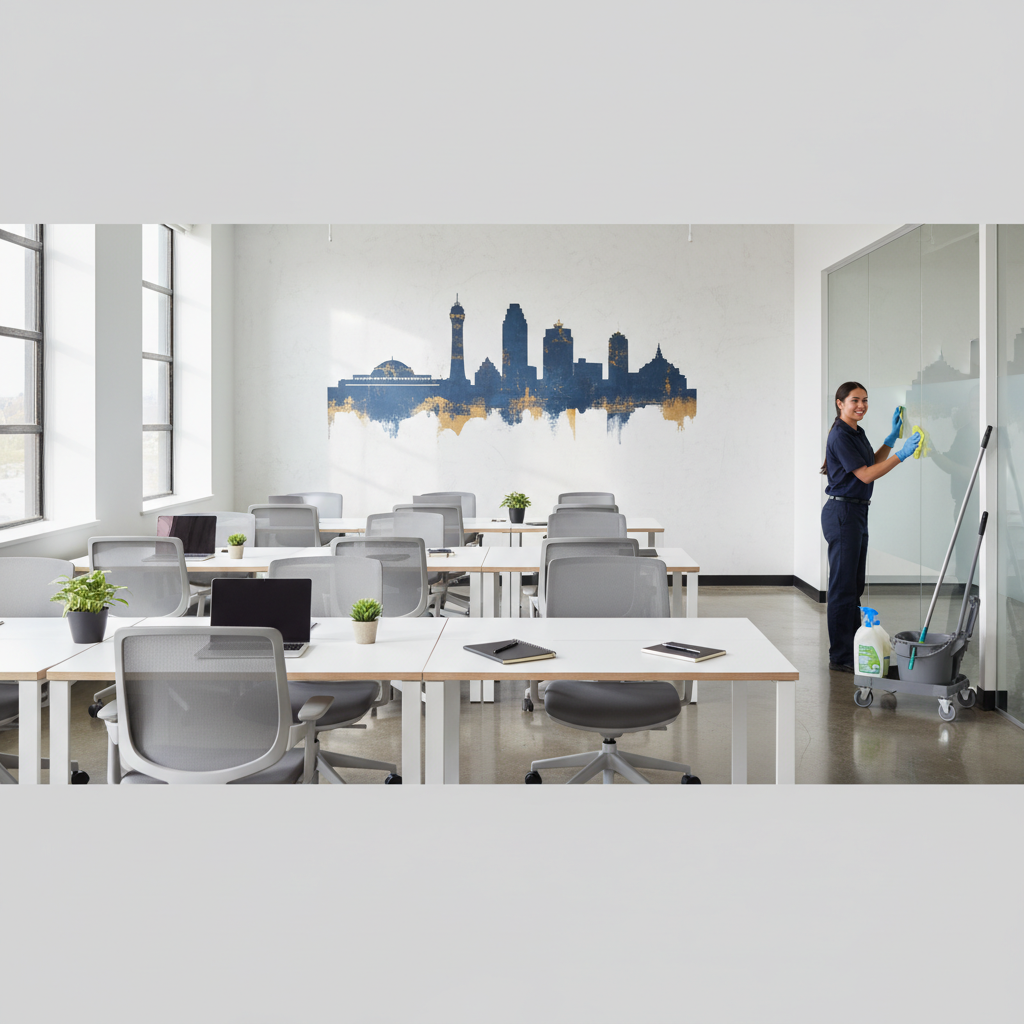December 19, 2025
No Comments
Beyond the Coffee Bar: Why Top-Tier Office Cleaning Services are Essential for KC’s Hybrid Workspaces
Kansas City’s professional landscape is rapidly evolving, with hybrid work models becoming the new standard. In this dynamic environment, innovative solutions like WEach Seats are transforming the way we work, repurposing beloved neighborhood restaurants and gastropubs into vibrant, fully-equipped coworking spaces during weekday hours. These unique venues offer the perfect blend of comfort, community, and productivity, moving beyond the traditional office walls. However, the success and appeal of such flexible, shared environments hinge not just on their amenities but profoundly on their upkeep. This is precisely why securing professional office cleaning services KC is not merely a luxury, but an absolute necessity for ensuring health, safety, and a consistently positive experience for every member and guest who walks through the door.
The New Face of Work: Flexibility Meets Functionality
The traditional 9-to-5 office is increasingly a relic of the past. Today’s workforce craves flexibility, community, and environments that inspire creativity without the rigid constraints of corporate buildings. WEach Seats directly addresses this need, offering a fresh perspective on coworking by utilizing existing, beloved community spaces. Members gain access to high-speed internet, comfortable seating, and a professional atmosphere, all within the inviting ambiance of a local eatery.
This innovative approach fosters a sense of belonging and offers unparalleled convenience for professionals across Kansas City. Imagine starting your workday with a gourmet coffee in a space that feels both familiar and productive, then seamlessly transitioning to a team meeting in a semi-private booth. This flexibility is a huge draw, allowing individuals and small teams to optimize their work-life balance and avoid long commutes to centralized offices. However, with multiple users cycling through these spaces daily, the challenge of maintaining pristine conditions becomes paramount.
Health and Safety: A Non-Negotiable Priority in Shared Spaces
In a post-pandemic world, health and safety protocols have moved from being an afterthought to a fundamental expectation. For shared workspaces, particularly those that double as public dining establishments, the stakes are even higher. Members need to feel confident that their workspace is not only clean but truly sanitized, minimizing the risk of germ transmission.
Professional cleaning services go far beyond a quick wipe-down. They employ industry-grade disinfectants, specialized equipment, and trained personnel who understand the nuances of high-traffic areas and frequently touched surfaces. This meticulous attention to detail ensures that desks, chairs, doorknobs, restrooms, and common areas are thoroughly cleaned and disinfected, creating a healthier environment for everyone. When members feel safe and protected, their focus shifts entirely to their work, enhancing their overall experience and loyalty to the WEach Seats network.
First Impressions and Brand Reputation: The Cleanliness Factor
In the competitive landscape of coworking, first impressions are everything. When a prospective member visits a WEach Seats location, or an existing member brings a client for a meeting, the immediate visual impact of the space plays a crucial role in their perception. A sparkling clean environment immediately conveys professionalism, attention to detail, and a high standard of care – all qualities that reflect positively on the WEach Seats brand.
Conversely, a space that appears neglected or unclean can quickly erode trust and deter potential members. Dust, smudges, sticky surfaces, or unpleasant odors can create an unconscious negative bias, regardless of how excellent the amenities or community might be. Investing in top-tier cleaning services is an investment in your brand’s reputation, ensuring that every WEach Seats location consistently presents itself as a premium, desirable workspace that truly values its members.
Boosting Productivity and Member Well-being
It’s no secret that our physical surroundings directly impact our mental state and productivity. A cluttered, dirty, or disorganized workspace can be a significant source of distraction and stress, making it harder to concentrate and perform at one’s best. For individuals utilizing WEach Seats locations, the ability to focus and be productive is the primary reason they choose these spaces.
A professionally cleaned environment fosters a sense of calm and order, allowing members to settle in quickly and dive into their tasks without unnecessary interruptions or anxieties. Fresh air, clean surfaces, and an inviting atmosphere contribute to overall well-being, reducing stress and promoting a more positive outlook on the workday. By providing consistently clean spaces, WEach Seats actively supports the mental and physical health of its members, directly contributing to their success and satisfaction.
Protecting Your Investment: Longevity for Multi-Purpose Venues
WEach Seats operates within existing restaurant and gastropub infrastructure, which means these spaces are designed for durability but also experience significant wear and tear from their dual functionality. From the dining tables that become workstations to the upholstered booths that host brainstorming sessions, and the restrooms that serve both daytime workers and evening diners, every element needs meticulous care to maintain its appearance and extend its lifespan.
Professional cleaning services understand how to properly care for various materials, from wood and tile to fabric and leather, using appropriate products and techniques to prevent damage and preserve quality. Regular, expert cleaning not only keeps the spaces looking fresh but also protects the significant investment in furniture, fixtures, and equipment. This proactive approach minimizes the need for costly repairs or premature replacements, ensuring that WEach Seats locations remain attractive and functional for years to come, maximizing the value of these repurposed venues.
The Unique Challenges of Restaurant-Turned-Office Cleaning
Cleaning a traditional office is one thing; maintaining a restaurant that doubles as a coworking space presents a unique set of challenges. Restaurants have specific areas like kitchens, bars, and dining rooms that require specialized cleaning protocols, even if only used for coffee service during the day. There’s also the lingering scent of last night’s dinner, the potential for spills from morning coffee, and the constant traffic of people moving between different zones.
Expert cleaning services are equipped to handle these complexities. They possess the knowledge and tools to tackle grease, food particles, beverage stains, and high-traffic floor areas, ensuring that the space transitions seamlessly from a vibrant restaurant to a professional office environment each morning. Their expertise guarantees that all areas, including often-overlooked spots, receive the attention they need, leaving no trace of the previous day’s activities and preparing the space perfectly for the next wave of remote workers.
Conclusion: The Undeniable Value of Professional Cleanliness for KC’s Hybrid Hubs
As Kansas City embraces the future of work with innovative solutions like WEach Seats, the foundational importance of a pristine environment cannot be overstated. These flexible, community-centric workspaces thrive on providing an exceptional experience, and at the heart of that experience lies impeccable cleanliness. From ensuring the health and safety of every member to upholding a stellar brand reputation, boosting productivity, and protecting valuable assets, top-tier office cleaning services are an indispensable partner for WEach Seats and similar hybrid models.
By entrusting the cleanliness of these unique venues to professionals, WEach Seats can continue to focus on what it does best: fostering community and providing inspiring, flexible workspaces that meet the evolving demands of Kansas City’s workforce. Ultimately, a clean space isn’t just about appearances; it’s about building trust, enhancing well-being, and empowering productivity in the dynamic world of hybrid work.






